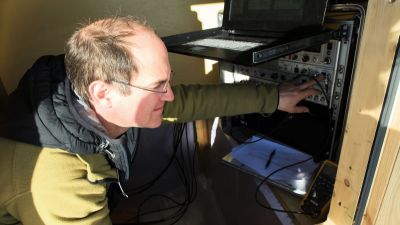
GIANT: An End of Season Talk with Olivier Francis
We got in touch with Olivier Francis (University of Luxembourg), who was responsible for the GIANT project this year, when he got back from Antarctica. In this article, he tells us more about the successes of the 2010-2011 campaign, but he also shares his thoughts on Antarctica and the Princess Elisabeth Station.
Olivier Francis, Professor at the Faculty of Science, Technology and Communications of the University of Luxemburg, has recently returned from Antarctica. He headed down to the Princess Elisabeth Station for six weeks for the project GIANT (Geodesy In ANTarctica), which aims to trace the horizontal and vertical deformation of the Earth's surface and focuses on the relation between ice mass variation and crust deformation in Antarctica.
This season has been successful for the GIANT project, but the Princess Elisabeth station will host many more expeditions over the course of the GIANT project. In order to eventually be able to tell whether Antarctica is experiencing melting or not, and if any, how significant the losses are, the project actually has to run uninterrupted over several years.
"It was a very rich experience", Professor Francis said, "and the project reached an important milestone as we were able to install all the instruments we wanted to install". The instruments put in place over the course of the 2010-2011 season are:
- A surface seismometer (measures the seismic waves resulting from ice and earthquakes),
- An absolute gravimeter (measures the local gravity in absolute units),
- A spring gravimeter,
- A second GPS.
This second GPS (from the University of Luxembourg) will serve as a back-up for the first one (from the Royal Observatory of Belgium) installed earlier in Utsteinen. While the two GPS and a seismometer stayed in Antarctica, the other instruments, which need fine-tuning and only collect data during the Austral summer, were taken back to Belgium.
The GIANT team also installed a box in one of the shelters to record the parameters that will eventually be used in designing instruments that are adapted to Antarctica. Doing so, the team hopes to solve the usual problems occurring with instruments that are not adapted to the extreme conditions of Antarctic weather and build instruments that will function on the deep-frozen continent.
According to Olivier Francis, "[t]he location of the station allows the measurements of the GIANT project to plug the hole between the measures taken at Novolazarevskaya (431km from PEA) and at the Japanese Syowa station (684km from PEA)". As ocean tides can influence the measurements significantly, he says, the station’s location further inland allows scientists to make their measurements without being influenced too much by the ocean water masses. Furthermore, the implementation of the station on rock "is an unmistakable advantage" as the measurements of GIANT can only be made on rock.
"The aim for next year, with LISSA (Lithospheric and Intraplate Structure and Seismicity in Antarctica will be to install temporary seismic stations 20km from the station for a year" in order to survey the lithosphere - the rocky surface underneath the ice - and study its structure to find out whether there are mountains underneath the ice sheet, and look for fracture zones.
Picture: Olivier Francis at work in one of the scientific shelters - © International Polar Foundation - René Robert
